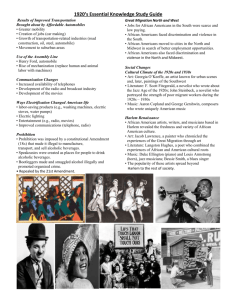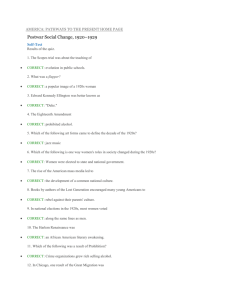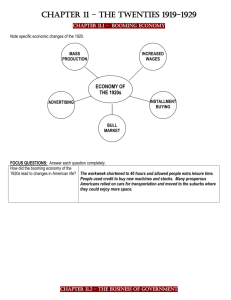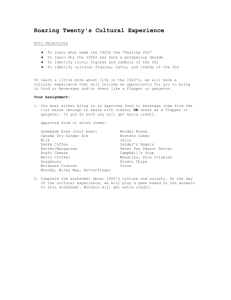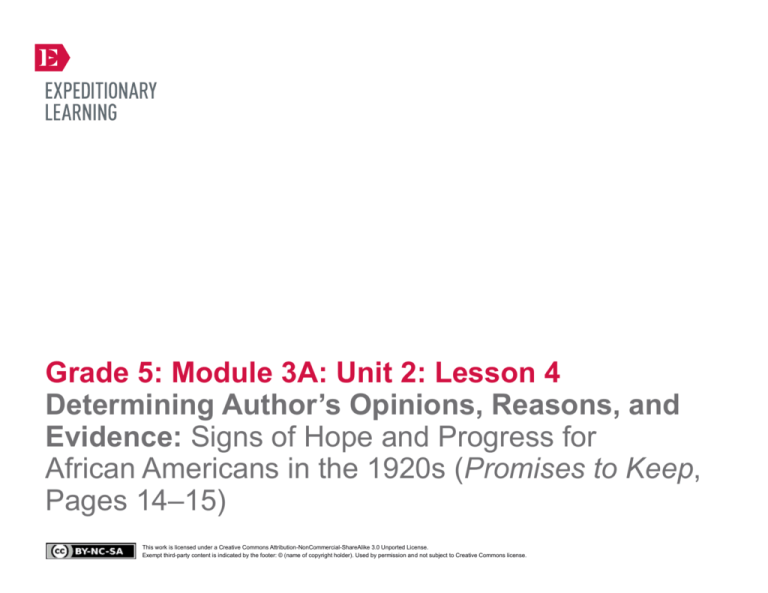
Grade 5: Module 3A: Unit 2: Lesson 4
Determining Author’s Opinions, Reasons, and
Evidence: Signs of Hope and Progress for
African Americans in the 1920s (Promises to Keep,
Pages 14–15)
This work is licensed under a Creative Commons Attribution-NonCommercial-ShareAlike 3.0 Unported License.
Exempt third-party content is indicated by the footer: © (name of copyright holder). Used by permission and not subject to Creative Commons license.
GRADE 5: MODULE 3A: UNIT 2: LESSON 4
Determining Author’s Opinions, Reasons, and Evidence:
Signs of Hope and Progress for
African Americans in the 1920s (Promises to Keep, Pages 14–15)
Long-Term Targets Addressed (Based on NYSP12 ELA CCLS)
I can explain what a text says using quotes from the text. (RI.5.1)
I can determine the main idea(s) of an informational text based on key details. (RI.5.2)
I can explain how authors use evidence and reasons to support their points in informational texts. (RI.5.8)
Supporting Learning Targets
Ongoing Assessment
• I can summarize the information in Promises to Keep about life for African Americans in the 1920s.
• Great Migration Venn diagram (homework from Lesson
3)
• I can identify the reasons and evidence Sharon Robinson uses to support an opinion about life for
African Americans in the 1920s.
• I can explain how the reasons I identify support Sharon Robinson’s opinion.
• Vocabulary cards
• Journal (Author’s Opinion, Reasons, and Evidence
graphic organizer)
• Evidence flags
Copyright © 2013 by Expeditionary Learning, New York, NY. All Rights Reserved.
NYS Common Core ELA Curriculum • G5:M3A:U2:L4 • June 2014 •
1
GRADE 5: MODULE 3A: UNIT 2: LESSON 4
Determining Author’s Opinions, Reasons, and Evidence:
Signs of Hope and Progress for
African Americans in the 1920s (Promises to Keep, Pages 14–15)
Agenda
Teaching Notes
1. Opening
• This lesson introduces a new graphic organizer: Author’s Opinion, Reasons, and Evidence. This
organizer builds directly on the Opinion and Evidence graphic organizer (from Unit 1). During Work
Time B, the distinction between the terms opinion, reasons, and evidence is defined for students.
Review and become familiar with these terms in order to define them clearly and consistently for
students.
A. Homework Review (5 minutes)
B. Engaging the Reader: Tea Party Protocol to Infer
about Life for African Americans in the 1920s (10
minutes)
2. Work Time
A. First Read: Getting the Gist about Life for African
Americans in the 1920s (10 minutes)
B. Guided Practice: Identifying Reasons and Evidence
That Support the Author’s Opinion (15 minutes)
C. Small Group Practice: Identifying Reasons and
Evidence That Support the Author’s Opinion (15
minutes)
3. Closing and Assessment
A. Debrief (5 minutes)
4. Homework
A. Read pages 16–19 of Promises to Keep. Answer
homework questions on index cards.
Copyright © 2013 by Expeditionary Learning, New York, NY. All Rights Reserved.
• The guided practice (Work Time B) is particularly important for the overall success of the module, since
it lays the foundation for students’ writing in Unit 3. After students identify the author’s opinion,
reasons, and evidence, they work to explain how the reasons support the opinion. Encourage students to
explain their thinking and make clear connections between the opinion and reasons by using statements
such as: “The opinion _____ is supported by the reason _____ BECAUSE the reason is an example of
_____.” These skills also are reinforced in future lessons.
• During Opening B, students will participate in the Tea Party protocol. They read and discuss Tea Party
cards with information from the picture captions on pages 14 and 15 of Promises to Keep in order to
make inferences about what life was like in the 1920s for African Americans. There are only eight Tea
Party cards, so at least three students should receive the same card.
• In advance: Add to the Jackie Robinson and Life in America anchor chart, which students work with
during the closing of this lesson. In the far left-hand column write: “During Jackie Robinson’s
Childhood.” In the center column, write: “1920s.”
• Review: Tea Party protocol (see Appendix).
• Post: Learning targets.
NYS Common Core ELA Curriculum • G5:M3A:U2:L4 • June 2014 •
2
GRADE 5: MODULE 3A: UNIT 2: LESSON 4
Determining Author’s Opinions, Reasons, and Evidence:
Signs of Hope and Progress for
African Americans in the 1920s (Promises to Keep, Pages 14–15)
Lesson Vocabulary
Materials
opinion (Unit 1), reasons, evidence
(Unit 1); operated, anti-segregation,
resistance (14), Harlem Renaissance,
rose (v., past tense of “rise”) (15)
• Tea Party cards (enough so that each student gets a different one)
• Promises to Keep (book; one per student)
• Features of Informational Text anchor chart (from Module 2A, Unit 1, Lessons 1 and 2)
• Document camera or projector
• Students’ journals
• Author’s Opinions, Reasons, and Evidence graphic organizer (one for display)
• Evidence flags (small sticky notes, four per student)
• Lesson 4 task card (one per group)
• Vocabulary Strategies anchor chart (from Unit 1, Lesson 1)
• Jackie Robinson and Life in America anchor chart (begun in Lesson 2)
• Index cards (three per student)
Opening
Meeting Students’ Needs
A. Homework Review (5 minutes)
• Intentionally partner ELL students
with other students who speak the
same home language.
• Ask students to meet with partners to share the Great Migration Venn diagram and two of the vocabulary cards they
completed for homework.
Copyright © 2013 by Expeditionary Learning, New York, NY. All Rights Reserved.
NYS Common Core ELA Curriculum • G5:M3A:U2:L4 • June 2014 •
3
GRADE 5: MODULE 3A: UNIT 2: LESSON 4
Determining Author’s Opinions, Reasons, and Evidence:
Signs of Hope and Progress for
African Americans in the 1920s (Promises to Keep, Pages 14–15)
Opening (continued)
Meeting Students’ Needs
B. Engaging the Reader: Life in the 1920s for African Americans (10 minutes)
• Intentionally give the same Tea
Party protocol cards to a
heterogeneous mix of students, so
students who may need support will
end up working with stronger
readers.
• Remind students they are learning about what life was like for African Americans in the United States both before and
during Jackie Robinson’s life. This will help them better understand the impact Jackie Robinson made on American society
as he overcame barriers of segregation and racism.
• Tell students they will use the Tea Party protocol to read information about famous African Americans to help them make
inferences about what life was like for African Americans in the 1920s.
• Cold call several students to recall the meaning of the word inference (ideas we have based on what we read, hear, or see).
• Remind students that they participated in a Tea Party in Unit 1 of this module, when they were beginning to build their
background knowledge about the importance of sports in American culture.
• Explain that each student will receive a card with information about a famous African American who lived during the 1920s.
Distribute the Tea Party cards. (Make sure at least three students receive the same card.)
• Give directions for students to prepare for the Tea Party:
• Write the directions for preparing
for the Tea Party protocol and Tea
Party on the white board for
students to reference as they work.
• Students who struggle with writing
may need to dictate their inference
to a partner or teacher.
1. On your own, read the information on your card.
2. Then make an inference about what life was like for African Americans, based on the information.
3. Write your inference on the back of your card.
• Give students 3 or 4 minutes to read their cards and write inferences.
• Give the next directions for the actual tea party. Students will circulate around the room and do the following:
1. First, find the individuals who have the same information.
2. Then discuss the similarities (compare) and differences (contrast) between their inferences (2 to 3 minutes).
3. Finally, meet with at least one other peer who has a different piece of information to discuss their information and
inferences (2 to 3 minutes).
Copyright © 2013 by Expeditionary Learning, New York, NY. All Rights Reserved.
NYS Common Core ELA Curriculum • G5:M3A:U2:L4 • June 2014 •
4
GRADE 5: MODULE 3A: UNIT 2: LESSON 4
Determining Author’s Opinions, Reasons, and Evidence:
Signs of Hope and Progress for
African Americans in the 1920s (Promises to Keep, Pages 14–15)
Meeting Students’ Needs
Opening (continued)
• Ask students to return to their seats and turn and talk with a peer:
* “What did you infer about what life was like for African Americans during the 1920s?”
• Ask several students to share out their inferences. Listen for:
– “African Americans were speaking out about the violence they suffered.”
– “They were making changes in society by starting schools and organizations like the NAACP.”
– “There were famous African American authors, poets, actors, entrepreneurs, educators.”
Work Time
Meeting Students’ Needs
A. First Read: Getting the Gist about Life for Americans in the 1920s (10 minutes)
• Strategically group stronger readers
and writers with students who
struggle with grade-level text.
• Ensure all students have access to Promises to Keep and ask them to sit with their small group. Students will remain in
groups until Closing and Assessment.
• Provide Promises to Keep for ELL
students in the students’ home
language.
• Read the first learning target with the students:
* “I can summarize the information in Promises to Keep about life for African Americans in the 1920s.”
• Direct students to open their books to pages 14 and 15, and display the Features of Informational Text anchor chart
(from Lesson 1) using a document camera or projector. Ask students to first review features already listed for
biographies (a narrative, like a story; has a lot of details about a person’s life and times; told in chronological order; includes
pictures of the person at different ages, etc.).
• Then ask students to look closely at pages 14 and 15 to identify text features they notice. Ensure that they identify the
photographs and captions on the sides and bottoms of these pages. Ask several students to share out how these text features
help us as readers. Listen for:
– “Photographs help us ‘see’ the people the text may refer to.”
– “Captions share important details about the pictures.”
Copyright © 2013 by Expeditionary Learning, New York, NY. All Rights Reserved.
• Students may need to review how to
summarize based on details from
text (from Lesson 3).
• Some students may need the text
reread a second time to determine
the gist.
• Struggling writers may need to
dictate their gist to a partner or
teacher.
NYS Common Core ELA Curriculum • G5:M3A:U2:L4 • June 2014 •
5
GRADE 5: MODULE 3A: UNIT 2: LESSON 4
Determining Author’s Opinions, Reasons, and Evidence:
Signs of Hope and Progress for
African Americans in the 1920s (Promises to Keep, Pages 14–15)
Meeting Students’ Needs
Work Time (continued)
• Ask students what they typically do when they first read a new text. Listen for students to say:
– “Read to determine the gist.”
– “Summarize the main idea of the text.”
• Ask students to follow along silently as they hear a first read of the main text on pages 14 through 15 (start with “While my
father fought …” and end with “… fame and popularity through the Harlem Renaissance”).
• Prompt students to take 1 or 2 minutes to think about and discuss with their group members:
* “What is the gist of this passage?”
* “What was life like for African Americans in the 1920s?”
• Direct students to turn to a new page in their students’ journals to record the gist of this passage.
• Cold call a few students to share what they have written. Listen for ideas such as:
– “African American leaders were working to change the way black people were treated in America.”
– By the 1920s, African Americans owned businesses and worked as teachers, nurses, doctors, and lawyers.”
B. Guided Practice: Identifying Reasons and Evidence That Support the Author’s Opinion (15 minutes)
• Read the second learning target aloud:
* “I can identify the reasons and evidence Sharon Robinson uses to support an opinion about life for African Americans in
the 1920s.”
• Say: “Sharon Robinson shares many opinions throughout this book.” Ask several students to share what they recall about the
word opinion, from Unit 1. Listen for:
–
–
–
–
“A person’s point of view.”
“Position on an issue.”
“Not everyone may agree.”
“Can be argued.”
• Provide visual clues (e.g., a
magnifying glass for identify, a
person holding up another person
for support) for academic
vocabulary words in learning
targets.
• Provide a copy of the Author’s
Opinions, Reasons, and Evidence
graphic organizer for those students
who struggle with copying
information into their journals.
• Display the Author’s Opinions, Reasons, and Evidence graphic organizer and ask students to create this graphic
organizer on a new page in their journals.
Copyright © 2013 by Expeditionary Learning, New York, NY. All Rights Reserved.
NYS Common Core ELA Curriculum • G5:M3A:U2:L4 • June 2014 •
6
GRADE 5: MODULE 3A: UNIT 2: LESSON 4
Determining Author’s Opinions, Reasons, and Evidence:
Signs of Hope and Progress for
African Americans in the 1920s (Promises to Keep, Pages 14–15)
Work Time (continued)
Meeting Students’ Needs
• Point out the Author’s Opinion (WHAT the author believes) line at the top of the organizer. Say:
• Provide visual clues for Opinion (an
exclamation point), Reasons (a
question mark), and Evidence (a
check mark).
* “The author’s opinion, or point of view, can also be thought of as WHAT the author believes.”
• Remind students that in Unit 1 they determined the author’s opinion within small chunks of text. In this unit, however, they
will determine the author’s opinion for a passage, or several pages of a text.
• Explain to students that authors will let us know “What” they think (their “opinion”) somewhere within the passage of text
(beginning, middle, or end). Authors support their opinions by providing reasons and evidence.
• Point out the lines titled “Reason” (WHY the author believes an opinion) to students. Explain that this is a new element they
will begin to identify in an author’s argument. Say to students: “An author’s opinion is WHAT the author believes. The
reasons an author provides to support an opinion tells us ‘why’ the author believes the opinion.”
• Then direct students’ attention to the two lines titled “Evidence.” Ask students to recall what evidence is, from Unit 1 (facts,
specific details).
• Tell students they will now work with their group members to determine the author’s opinion—WHAT the author believes—
for the passage on pages 14 and 15. Orient students to the text. Ask them to number the paragraphs of the main text on pages
12 to 15 (there are four paragraphs total). (Be sure students know to focus on the text on the white borders, not the captions
they worked with earlier, which are on the orange borders.)
• Some students may need the
portion of text reread a second time
in order to determine the author’s
opinion, reasons, and evidence.
• Write, or chart, the directions to
complete with their group members
on the white board so that students
may reference them while they
work.
• Focus students’ attention on page 14, Paragraphs 1 and 2 (starting with “While my father …” and ending “… signs of hope
and progress”). Ask students to follow along silently as these two paragraphs are read aloud.
• Give students 1 or 2 minutes to discuss in their groups:
* “WHAT is the author’s opinion about life for African Americans in the 1920s?”
• Invite several students to share their thinking whole group. Listen for: “By the 1920s there were visible signs of hope and
progress for African Americans.” Write this on the line next to Author’s Opinion, and ask students to record the opinion onto
the graphic organizers in their journals.
Copyright © 2013 by Expeditionary Learning, New York, NY. All Rights Reserved.
NYS Common Core ELA Curriculum • G5:M3A:U2:L4 • June 2014 •
7
GRADE 5: MODULE 3A: UNIT 2: LESSON 4
Determining Author’s Opinions, Reasons, and Evidence:
Signs of Hope and Progress for
African Americans in the 1920s (Promises to Keep, Pages 14–15)
Meeting Students’ Needs
Work Time (continued)
• Probe students’ thinking by asking:
* “How is this an opinion?”
* “Can it be argued or could someone disagree?”
• Listen for students to share ideas such as: “It is an opinion because not everyone may agree there were signs of change or
hope for African Americans in the 1920s.”
• Focus students’ attention on Paragraph 3, pages 14 and 15 (starting “Black-owned and operated …” and ending “… encourage
an anti-segregation resistance movement.”).
• Say: “Now we will read the third paragraph to determine one reason WHY Sharon Robinson believes there were signs of
hope and progress for African Americans in the 1920s.” Read aloud as students follow along silently.
• Say to students: “As I read this paragraph aloud, I heard that there were several black-owned and operated newspapers. I
think this is part of WHY Sharon Robinson believes there were signs of hope and progress for African Americans in the
1920s, because we learned that before the 1920s African Americans had been enslaved, segregated, and would have been
kept from owning a business.”
• Paraphrase the text and write: “African Americans owned and managed newspapers,” next to the first Reason line on the
graphic organizer. Ask students to record this on their graphic organizers.
• Direct students’ attention to the two lines on the graphic organizer below the first Reason, titled Evidence. Ask students to
recall what “evidence” is, from Unit 1 (facts, specific details, information).
• Distribute four evidence flags to each student (students will use two evidence flags in Work Time B, and two in Work Time
C).
• Tell students to take 3 or 4 minutes to complete the following with their group members:
1. Reread the third paragraph to identify evidence (facts, specific details, information) about the newspapers owned and
run by African Americans.
2. Mark the evidence you locate with evidence flags.
3. Discuss with your group members the evidence you locate.
Copyright © 2013 by Expeditionary Learning, New York, NY. All Rights Reserved.
NYS Common Core ELA Curriculum • G5:M3A:U2:L4 • June 2014 •
8
GRADE 5: MODULE 3A: UNIT 2: LESSON 4
Determining Author’s Opinions, Reasons, and Evidence:
Signs of Hope and Progress for
African Americans in the 1920s (Promises to Keep, Pages 14–15)
Meeting Students’ Needs
Work Time (continued)
• After students reread, mark evidence, and discuss with their group members, ask:
* “What evidence (facts, details) did you locate in this paragraph about newspapers owned and managed by African
Americans?”
• Listen for:
– “There were black-owned newspapers in major cities like Chicago, Pittsburgh, and Boston.”
– “There were newspapers and magazines that wrote specifically for and about the story and life of African Americans.”
– “Black-owned newspapers and magazines told stories of progress.”
– “Encouraged an anti-segregation movement.”
• Paraphrase and record students’ responses on the graphic organizer. Ask students to record paraphrased evidence on the
graphic organizers in their journals.
• Tell students that in the next step of Work Time, they will work in their groups to identify another reason and supporting
evidence for Sharon Robinson’s opinion that there were signs of hope and progress for African Americans in the 1920s.
C. Small Group Practice: Identifying Reasons and Evidence That Support the Author’s Opinion (15 minutes)
• Remind students they are still working on the same learning target.
• Focus students’ attention on Paragraph 4 (the main paragraph on page 15, starting: “There was also a small but growing …”
and ending “… fame and popularity through the Harlem Renaissance”). Display and distribute the Lesson 4 task cards
(one per group).
• Some groups may need additional
time to identify additional reasons
and evidence.
• Read each step of the task card aloud to students. Clarify directions as necessary. Direct students to take 7 to 8 minutes to
complete the steps listed on their task cards.
Copyright © 2013 by Expeditionary Learning, New York, NY. All Rights Reserved.
NYS Common Core ELA Curriculum • G5:M3A:U2:L4 • June 2014 •
9
GRADE 5: MODULE 3A: UNIT 2: LESSON 4
Determining Author’s Opinions, Reasons, and Evidence:
Signs of Hope and Progress for
African Americans in the 1920s (Promises to Keep, Pages 14–15)
Meeting Students’ Needs
Work Time (continued)
• Circulate to support as needed. As students read, focus their attention on key vocabulary in this paragraph:
– Harlem Renaissance (an African American cultural and artistic movement of the 1920s that centered on the neighborhood
of Harlem, in New York)
– rose (the past tense of the verb “rise,” meaning “became more successful”)
• Encourage students to refer to the Vocabulary Strategies anchor chart for support with determining the meaning of
unfamiliar words or phrases.
• After 7 to 8 minutes, refocus students whole group. Cold call several students to share out the Reason and Evidence they
identified to support the author’s opinion. Listen for:
– “The author’s opinion that there was progress for African Americans in the 1920s is supported by the reasons such as:
There was a growing group of professional African Americans. Evidence to support this includes the fact that African
Americans taught school and were nurses, doctors, lawyers, and business owners. In addition, the Harlem Renaissance
gave us great African American writers, artists and musicians.”
• Ask:
* “How do the reason and evidence you identified in Paragraph 4 support the author’s opinion that there was progress for
African Americans in the 1920s?”
• Listen for students to make connections between the opinion and the reasons and evidence they identified. For example:
“Sharon Robinson supports her opinion that there were signs of progress for African Americans in the 1920s by giving the
reason that there were a growing number of African Americans in professional jobs. This reason supports the opinion
because in the past, African Americans had been forced into slavery and were kept out of professional careers through
segregation laws. The evidence gives specific examples of the types of professional jobs African Americans held in the 1920s,
such as doctors, lawyers, nurses, and educators.”
• Help students recognize that while Sharon Robinson believes there were “visible signs of hope and progress” for African
Americans during the 1920s, the United States was still segregated. Emphasize the importance of this as they keep reading
about Jackie Robinson’s life because it will help them better understand that there were still significant barriers to
overcome.
• Congratulate students on their first try at working to identify reasons and giving evidence to support an opinion.
• Collect students’ journals to review as an ongoing assessment.
Copyright © 2013 by Expeditionary Learning, New York, NY. All Rights Reserved.
NYS Common Core ELA Curriculum • G5:M3A:U2:L4 • June 2014 •
10
GRADE 5: MODULE 3A: UNIT 2: LESSON 4
Determining Author’s Opinions, Reasons, and Evidence:
Signs of Hope and Progress for
African Americans in the 1920s (Promises to Keep, Pages 14–15)
Closing and Assessment
Meeting Students’ Needs
A. Debrief (5 minutes)
• Provide sentence stems or starters
(e.g., “One thing that happened in
America in the 1920s was
_____________.”) for students
who struggle with language.
• Gather students whole group. Focus their attention back on the Jackie Robinson and Life in America anchor chart.
Say: “As we read today we learned many more details about what life was like in America for African Americans in the
1920s.”
• Ask students to take 1 minute to turn and talk with a partner about details they could add to the far right-hand column of the
anchor chart:
* “What was happening in America during the 1920s?”
• Ask several students to share their thinking aloud. Listen for ideas such as:
– “There were signs of progress for African Americans.
– “There were black-owned businesses.”
– “African Americans held professional jobs.”
– “The Harlem Renaissance took place.”
• Add students’ ideas to the anchor chart.
• Read the first learning target aloud:
* “I can summarize the information in Promises to Keep about life for African Americans in the 1920s.”
• Ask students to indicate their progress toward the learning targets by showing thumbs-up or thumbs-down.
• Repeat with the second and third learning targets:
* “I can identify the reasons and evidence Sharon Robinson uses to support an opinion about life for African Americans in
the 1920s.”
* “I can explain how the reasons I identify support Sharon Robinson’s opinion.”
• Note students who show thumbs-down, as they may need more support summarizing information, or help identifying
reasons and evidence that an author uses to support an opinion.
• Distribute three index cards to each student for homework.
Copyright © 2013 by Expeditionary Learning, New York, NY. All Rights Reserved.
NYS Common Core ELA Curriculum • G5:M3A:U2:L4 • June 2014 •
11
GRADE 5: MODULE 3A: UNIT 2: LESSON 4
Determining Author’s Opinions, Reasons, and Evidence:
Signs of Hope and Progress for
African Americans in the 1920s (Promises to Keep, Pages 14–15)
Homework
Meeting Students’ Needs
• Read pages 16–19 of Promises to Keep. On one of your index cards, write a gist statement about the information on pages
16–19 of Promises to Keep.
• Provide an audio recording of
Promises to Keep for students who
struggle with reading at grade level.
• Choose two of the following vocabulary words from today’s lesson: opinion, reasons, evidence, operated,
segregation, resistance, Harlem Renaissance, rose (v.).
anti-
• Record each word on an index card. On the back of each index card, draw a picture to show what the word means AND write
a definition for the word. Bring your three index cards as an admit ticket to the next class.
Note: Review students’ journals to determine their current level of understanding about opinion, reasons, and evidence.
Copyright © 2013 by Expeditionary Learning, New York, NY. All Rights Reserved.
• Consider prewriting vocabulary
words on index cards for students
who struggle with writing.
• Students who struggle with
language may need to dictate the
gist and the definitions of their
vocabulary words to someone at
home.
NYS Common Core ELA Curriculum • G5:M3A:U2:L4 • June 2014 •
12
Grade 5: Module 3A: Unit 2: Lesson 4
Supporting Materials
This work is licensed under a Creative Commons Attribution-NonCommercial-ShareAlike 3.0 Unported License.
Exempt third-party content is indicated by the footer: © (name of copyright holder). Used by permission and not subject to Creative Commons license.
GRADE 5: MODULE 3A: UNIT 2: LESSON 4
Tea Party Cards
Directions: Make enough copies of this page so that you can cut the page into strips and give each
student a single excerpt.
1. Ida B. Wells (1862–1931) was a journalist born in Mississippi. She used the media to expose
the violence African Americans were often subjected to in the 1890s and the early 20th
century.
2. W.E.B. (William Edward Burghardt) Dubois (1868–1963) was a scholar and writer who
believed African Americans should be educated and activists. He was one of the founders of the
nation’s first biracial civil rights organization, which later became the National Association for
the Advancement of Colored People (NAACP).
3. Madame C. J. Walker (1867–1919), a self-made millionaire and entrepreneur, amassed a
fortune through her cosmetics business. Walker was an important supporter of the Harlem
Renaissance.
4. Booker T. Washington (1856–1915), a former slave, became a leading educator, author, and
spokesperson for African Americans. He headed the Tuskegee Institute in Alabama, an allblack college where students learned vocational skills.
5. Duke Ellington (1899–1974), a legendary bandleader, took his famous jazz-swing orchestra
all around the world.
6. Paul Robeson (1898–1976), an extraordinary singer and stage and film actor, stunned
audiences with his powerful performances.
7. Langston Hughes (1902–1967), a famous poet-playwright-essayist-novelist, captured the
heart and voice of the African American experience in his work.
8. Zora Neale Hurston (1891–1960), an anthropologist and novelist, is best known for her
book Their Eyes Were Watching God, published in 1937.
Copyright © 2013 by Expeditionary Learning, New York, NY. All Rights
Reserved.
NYS Common Core ELA Curriculum • G5:M3A:U2:L4 • June 2014 •
14
GRADE 5: MODULE 3A: UNIT 2: LESSON 4
Author’s Opinion, Reasons, and Evidence Graphic Organizer
Name:
Date:
Author’s Opinion (WHAT the author believes):
Reason (WHY
the author
believes an
opinion):
Evidence
(facts, details,
information):
Evidence:
Copyright © 2013 by Expeditionary Learning, New York, NY. All Rights
Reserved.
NYS Common Core ELA Curriculum • G5:M3A:U2:L4 • June 2014 •
15
GRADE 5: MODULE 3A: UNIT 2: LESSON 4
Lesson 4 Task Card
Work with your
group members to
complete the
following:
1. Read the last paragraph on page 15.
2. Think about and discuss: What reason does the author give to support
her opinion?
3. On your graphic organizer, record the reason you identify next to
second line titled “Reason.”
4. Locate two pieces of evidence that support the reason you identified.
Mark these with evidence flags.
5. Discuss the evidence you located with your group members.
6. Paraphrase the evidence you identified and record onto your graphic
organizer, next to the lines titled “Evidence.”
Copyright © 2013 by Expeditionary Learning, New York, NY. All Rights
Reserved.
NYS Common Core ELA Curriculum • G5:M3A:U2:L4 • June 2014 •
16



